HOME SCIENCE
Paper – III
Note : This paper contains seventy five (75) objective type questions of two (2) marks each. All questions are compulsory.
1. Haemoglobin level below which a pregnant woman is considered anaemic :
(1) 12 g / dl of blood
(2) 11 g / dl of blood
(3) 11.5 g / dl of blood
(4) 10 g / dl of blood
2. The degree of unsaturation in fats is estimated by which method ?
(1) Acid value
(2) Saponification
(3) Benedict’s method
(4) Iodine value
3. The HbAlC level above which a person is diagnosed as Diabetic is :
(1) 6.2%
(2) 6.5%
(3) 6.8%
(4) 7.0%
4. Method of purchasing in which specifications of the equipment to be purchased are written out and quotations invited from sellers, by advertising in dailies or trade journals is called :
(1) Formal competitive bid buying
(2) Negotiated buying
(3) Auction buying
(4) Open market buying
5. Which of the following dyes is cationic in nature ?
(1) Acid
(2) Disperse
(3) Basic
(4) Direct
6. Wrinkle resistant fabrics are made environment friendly and cost effective by the use of
(1) Formaldehyde
(2) Citric acid
(3) Xylitol
(4) Cross linking citric acid and xylitol
7. ‘World Consumer Rights day’ is observed on which date ?
(1) 15th of March
(2) 8th of February
(3) 10th of December
(4) 16th of March
8. The branch of cognitive ergonomics deals with which concept given below ?
(1) Anthropometry
(2) Biomechanical characteristics
(3) Human computer interaction
(4) Quality management
9. _____ consists of procedures that combine conditioning and modelling to eliminate undesirable behaviours.
(1) Negative reinforcement
(2) Social exclusion
(3) Behaviour modification
(4) Corporal punishment
10. The _____ approach assumes that by entering into close contact with a social group, researchers can understand the beliefs and behaviours better than through interviews or questionnaires.
(1) Cross sectional
(2) Ethnographic
(3) Ecological
(4) Clinical
11. The approach used in Non-formal education (NFE) should be
(1) Teacher oriented
(2) Fun oriented
(3) Learner oriented
(4) Evaluation oriented
12. Innovative entrepreneurs may face a special challenge initially raising
(1) Development capital
(2) Structural capital
(3) Human capital
(4) Seed capital
13. Vitamin A is essential for maintaining the following functions in the body :
I. Normal vision
II. Blood clotting
III. Integrity of epithelial tissue
IV. Cognitive development
V. Immune response
Codes :
(1) I, II, III
(2) I, IV, V
(3) I, II, IV
(4) I, III, V
14. Following measurements are made in anthropometry assessment of individuals :
I. Weight
II. Blood pressure
III. Height
IV. Haemoglobin
V. MUAC
VI. Waist circumference
Codes :
(1) I, III, V, VI
(2) I, II, III, VI
(3) I, III, IV, VI
(4) I, IV, V, VI
15. Following are the criteria for identification of SAM children aged 6 months to 60 months :
I. Weight for height less than-3 S.D.
II. Weight for height less than-2 S.D.
III. MUAC less than 115 mm
IV. MUAC less than 120 mm
V. Oedema VI. Dehydration
Codes :
(1) I, IV, V
(2) I, III, V
(3) II, III, VI
(4) II, IV, VI
16. Following foods have low glycemic index :
I. Cornflakes
II. Rajmah
III. White bread
IV. Oats
V. Apple
Codes :
(1) I, II, V
(2) II, IV, V
(3) I, III, IV
(4) II, III, V
17. Following are the criteria for diagnosis of metabolic syndrome :
I. Abdominal obesity
II. Fasting blood sugar < 100 mg/dl
III. Elevated blood pressure
IV. High HDL cholesterol level
V. High LDL cholesterol level
Codes :
(1) I, III, V
(2) I, II, III
(3) I, III, IV
(4) I, II, V
18. Which of the following are the informal pricing methods ?
I. Cost plus
II. Competitive
III. Rate of return
IV. Trial and error
Codes :
(1) I and III
(2) II and IV
(3) I and II
(4) II and III
19. Higher percentage of amorphous regions exhibit the following properties in a fibre.
I. Lower chemical resistance
II. Stiff handle
III. More absorbent
IV. Low inter-polymer forces of attraction
V. Strong internal bonds
Codes :
(1) I, II, III
(2) II, III, IV
(3) III, IV, V
(4) I,III, IV
20. Nano wire coating for clothes has been found useful as they
I. Trap the heat from the body
II. Keep the wearer cool
III. Saves electricity
IV. Have improved insulation
Codes :
(1) I, III, IV
(2) II, III, IV
(3) I, II, III
(4) I, II, IV
21. Which of the following are types of Kantha ?
I. Lep
II. Durjani
III. Sujni
IV. Tilpatra
V. Chope
Codes :
(1) I, II, and III
(2) II, III and IV
(3) III, IV and V
(4) I, III and V
22. Choose the activities involving mental effort in home making :
I. Reaching
II. Reasoning
III. Watching
IV. Thinking
V. Decision making
Codes :
(1) I, II and III
(2) I, III and IV
(3) II, IV and V
(4) II, III and IV
23. Identify the aspects that contribute to a family’s hidden income :
I. Community facilities
II. Consumer savings through bargaining
III. Mortgages
IV. Employment benefits
V. Loans from banks
Codes :
(1) I, II and IV
(2) I, III and IV
(3) I, III and V
(4) I, II and III
24. Which are the four rights given to consumers through the ‘Bill for Consumer Rights’ ?
I. Right to safety
II. Right to security
III. Right to choose
IV. Right to information
V. Right to redressal
VI. Right to be heard
Codes :
(1) I, III, V and VI
(2) I, III, IV and VI
(3) I, II, III and VI
(4) I, III, IV and V
25. The ecological systems theory defines the following systems that influence human development :
I. The ethno system
II. The meso system
III. The exo system
IV. The chrono system
Codes :
(1) II, III and IV
(2) I, II and III
(3) I, III and IV
(4) I, II and IV
26. Identify the concepts that are located in the domain of language development :
I. Overextension
II. Pragmatics
III. Syntax
IV. Origence
Codes :
(1) I, II and IV
(2) I, II and III
(3) II, III and IV
(4) I, III and IV
27. The following are defence mechanisms that reduce anxiety and guilt :
I. Regression
II. Intellectualization
III. Abstraction
IV. Sublimation
Codes :
(1) II, III and IV
(2) I, III and IV
(3) I, II and III
(4) I, II and IV
28. The fourth generation audio-visual aids as classified by the stage of their evolution include
I. Television
II. Printed text
III. Computers
IV. Electronic devices
Codes :
(1) I, II and III
(2) II, III and IV
(3) I, III and IV
(4) I, II and IV
29. The 3 R’s in literacy stand for
I. Reading
II. Writing
III. Arithmatic
IV. Response
Codes :
(1) I, II and III
(2) II, III and IV
(3) I, II and IV
(4) I, III and IV
30. A microlab as a training methodology helps to
I. Unfreeze participants
II. Reduce inhibitions of participants
III. Stimulates thinking
IV. Creates competition
Codes :
(1) I, II and III
(2) II, III and IV
(3) I, III and IV
(4) I, II and IV
31. Assertion (A) : Process indicators monitor the implementation of the activities of the programme.
Reason (R) : In vitamin A deficiency control programme the process indicator measures the percentage coverage of at risk population covered by programme.
Codes :
(1) Both (A) and (R) are correct.
(2) Both (A) and (R) are incorrect.
(3) (A) is correct, but (R) is incorrect.
(4) (A) is incorrect, but (R) is correct.
32. Assertion (A) : Ageing occurs at different rates in different people of same population groups.
Reason (R) : Genetics and environment are major determinants of the nature of ageing.
Codes :
(1) Both (A) and (R) are incorrect.
(2) Both (A) and (R) are correct.
(3) (A) is correct and (R) is incorrect.
(4) (A) is incorrect and (R) is correct.
33. Assertion (A) : Diets rich in MUFA have been associated with improved serum lipid control.
Reason (R) : MUFA helps in lowering serum total cholesterol and LDL cholesterol, without affecting HDL cholesterol.
Codes :
(1) (A) is incorrect, but (R) is correct.
(2) (A) is correct, but (R) is incorrect.
(3) Both (A) and (R) are incorrect.
(4) Both (A) and (R) are correct.
34. Assertion (A) : Chronic Renal failure patients are recommended diets limited in proteins and restricted in sodium.
Reason (R) : In chronic renal failure, the glomerular filteration rate falls to less than 15 ml/minute.
Codes :
(1) Both (A) and (R) are incorrect.
(2) Both (A) and (R) are correct.
(3) (A) is incorrect, but (R) is correct.
(4) (A) is correct, but (R) is incorrect.
35. Assertion (A) : Clean-in-place method of cleaning requires no disassembly or only partial disassembly of equipment.
Reason (R) : The pieces of equipment are cleaned and sanitized by circulation of chemical compounds through a piping system in clean-in-place method.
Codes :
(1) (A) is correct, but (R) is incorrect.
(2) (A) is incorrect, but (R) is correct.
(3) Both (A) and (R) are incorrect.
(4) Both (A) and (R) are correct.
36. Assertion (A) : Now-a-days it is easy to differentiate between designer clothes and knock offs.
Reason (R) : Thread with unique optical properties has ben produced which can be used to create invisible patterns in fabrics visible only under polarised light.
Codes :
(1) Both (A) and (R) are correct.
(2) Both (A) and (R) are incorrect.
(3) (A) is correct, but (R) is incorrect.
(4) (A) is incorrect, but (R) is correct.
37. Assertion (A) : Majority of threads intended for use in machine sewing are constructed with (S) twist.
Reason (R) : Thread with (Z) twist becomes untwisted by the action of machines and then fray and breaks.
Codes :
(1) Both (A) and (R) are incorrect.
(2) Both (A) and (R) are correct.
(3) (A) is correct, but (R) is incorrect.
(4) (A) is incorrect, but (R) is correct.
38. Assertion (A) : Cross dyeing can produce multicoloured fabrics.
Reason (R) : In this two or more fibre types accept a different dye and becomes a different colour.
Codes :
(1) Both (A) and (R) are correct. (2) Both (A) and (R) are incorrect.
(3) (A) is correct, but (R) is incorrect.
(4) (A) is incorrect, but (R) is correct.
39. Assertion (A) : A family budget is a way of detailing future expenses under different headings.
Reason (R) : It helps the family to live within the family’s income.
Codes :
(1) (A) is correct, but (R) is incorrect.
(2) Both (A) and (R) are correct.
(3) (A) is incorrect, but (R) is correct.
(4) Both (A) and (R) are incorrect.
40. Assertion (A) : Accumulation of excessive lactic acid in the muscles results in physiological fatigue.
Reason (R) : It is concerned more with the psychological attitude of the worker’s awareness or dislike to work.
Codes :
(1) (A) is correct, but (R) is incorrect.
(2) Both (A) and (R) are correct.
(3) (A) is incorrect, but (R) is correct.
(4) Both (A) and (R) are incorrect.
41. Assertion (A) : ‘Green Consumerism’ creates a balance between the expectations of consumer behaviour and businesses profit motives.
Reason (R) : A green consumer can convert the power of the consumer into a force for postive action to protect the environment.
Codes :
(1) Both (A) and (R) are true and (R) is the correct explanation of (A).
(2) Both (A) and (R) are true but (R) is not the correct explanation of (A).
(3) (A) is true, but (R) is false.
(4) (A) is false, but (R) is true.
42. Assertion (A) : The first outward sign of puberty is the rapid gain in height and weight.
Reason (R) : The secretion of insulin and cortisol stimulates the growth spurt.
Codes :
(1) Both (A) and (R) are true.
(2) Both (A) and (R) are false.
(3) (A) is true, but (R) is false.
(4) (R) is true, but (A) is false.
43. Assertion (A) : Institutionalization of orphans is the best option available to the government of India.
Reason (R) : An institutionalized child receives optimal care and protection required for his growth and development.
Codes :
(1) Both (A) and (R) are true.
(2) Both (A) and (R) are false.
(3) (A) is true, but (R) is false.
(4) (R) is true, but (A) is false.
44. Assertion (A) : Women as a constituency are becoming increasingly crucial in electoral contests.
Reason (R) : More and more women are exercising their agency and are conscious of their political rights.
Codes :
(1) (A) is correct, but (R) is incorrect.
(2) (A) is incorrect, but (R) is correct.
(3) Both (A) and (R) are correct.
(4) Both (A) and (R) are incorrect.
45. Assertion (A) : Social marketing differs from other types of marketing as its objective is not to benefit the marketer but to benefit the target audience and the general society.
Reason (R) : Its goal is not to market a product or service per se but to influence a social behaviour that usually carries high public consensus.
Codes :
(1) (A) is correct, but (R) is incorrect.
(2) (A) is incorrect, but (R) is correct.
(3) Both (A) and (R) are correct but (R) is not the correct reason for it.
(4) Both (A) and (R) are correct and (R) is the correct reason for it.
46. Arrange the foods in decreasing order of their iron content per 100 g of food :
I. Almonds
II. Lobia
III. Watermelon
IV. Methi leaves
V. Liver
Codes
(1) V,IV, I, II, III
(2) II, IV, V, III, I
(3) II, III, V, I, IV
(4) V, I, IV, III, II
47. Arrange in correct sequence the steps involved in conducting ‘24 hour dietary recall’.
I. Collecting information on the intake of food by respondent in previous 24 hours using standardized equipment.
II. Calculating the energy and nutrients using food composition tables.
III. Preparation and validation of questionnaire.
IV. Comparing the energy and nutrient intake with RDA.
V. Converting cooked food into weights and measures of raw food.
Codes :
(1) III, I, V, II, IV
(2) I, V, III, II, IV
(3) I, III, II, V, IV
(4) III, I, II, IV, V
48. Arrange in correct sequence the changes occurring in starch granules due to application of moist heat.
I. Starch chains in the starch granules absorb moisture and uncoil.
II. On application of heat hydrogen bonds break to facilitate the entry of water into granules.
III. Mixture becomes viscous and transparent.
IV. Starch granules form a suspension in cold water.
V. The size of starch granules increases.
Codes :
(1) II, I, IV, V, III
(2) IV, V, II, I, III
(3) I, II, IV, III, V
(4) IV, II, I, V, III
49. Arrange in correct sequence the stages of the development of atherosclerosis.
I. Calcification
II. Fibrous plaques
III. Fatty streaks
IV. Atheromatous plaques
V. Ulceration
VI. Thrombosis
Codes :
(1) III, II, IV, V, I, VI
(2) III, IV, II, I, V, VI
(3) IV, II, III, I, VI, V
(4) I, III, IV, II, VI, V
50. Arrange the steps of flow of food for a conventional food service system in the correct sequence.
I. Production
II. Storage
III. Holding
IV. Receiving
V. Service
Codes :
(1) IV, II, I, III, V
(2) I, III, II, IV, V
(3) IV, I, III, V, II
(4) I, II, IV, III, V
51. Give the correct sequence of making Ajrakh.
I. Application of gum
II. Dyeing in myrobalam
III. Washing of fabric
IV. Application of black colour
V. Dyeing with indigo
VI. Application of alum
Codes :
(1) II, III, I, IV, V, VI
(2) I, II, III, IV, V, VI
(3) III, II, I, IV, VI, V
(4) VI, V, IV, I, II, III
52. Give the correct sequence of cut order planning in a garment industry.
I. Determining whether there are available ‘markers’ or new ‘markers’ have to be made.
II. Examining incoming orders and piece goods availability.
III. Developing instructions for optimum fabric utilization.
IV. Releasing orders for marker making, spreading and cutting.
V. Develop volume, size ratios for marker making and spreading.
Codes :
(1) I, II, III, IV, V
(2) II, III, I, IV, V
(3) III, II, IV, V, I
(4) II, V, I, III, IV
53. Arrange the steps involved in systems approach to management in correct sequence :
I. Feedback
II. Throughput
III. Input
IV. Output
Codes :
(1) I, III, IV, II
(2) I, II, III, IV
(3) III, II, IV, I
(4) III, I, IV, II
54. Arrange the steps in making time plans in the proper sequence.
I. Merge individual plans with other plans for coordination.
II. Determine time sequence.
III. List all items to be included.
IV. Set down as accurate an estimate of time for each task.
V. Bring total estimated time needed and total available time into harmony.
VI. Write out plan.
Codes :
(1) III, IV, V, II, VI, I
(2) I, II, III, IV, V, VI
(3) III, II, I, VI, V, IV
(4) III, II, IV, I, VI, V
55. Arrange the following in accordance with the stages of loss and grief :
I. Acceptance
II. Anger
III. Bargaining
IV. Denial
V. Depression
Codes :
(1) II, V, III, I, IV
(2) IV, II, III, V, I
(3) II, IV, V, I, III
(4) IV, III, II, V, I
56. Arrange in accordance with Kohlberg’s stages of moral understanding.
I. Instrumental purpose orientation.
II. Punishment and obedience orientation.
III. Social-order-maintaining orientation.
IV. Good boy-good girl orientation.
Codes :
(1) II, I, IV, III
(2) II, IV, I, III
(3) I, II, IV, III
(4) II, I, III, IV
57. Arrange in order of sensorimotor substages, earliest to latest.
I. Secondary circular reactions
II. Coordination of secondary circular reactions
III. Mental representation
IV. Tertiary circular reactions
Codes :
(1) IV, I, II, III
(2) I, II, IV, III
(3) I, IV, II, III
(4) III, I, II, IV
58. Arrange the following as per the Maslow’s theory of hierarchy of needs for motivation.
I. Safety and security
II. Social needs – friendship and family.
III. Physiological needs – air and water.
IV. Self actualisation – creativity and problem solving.
V. Self esteem – confidence and achievement.
Codes :
(1) III, II, I, IV, V
(2) III, I, II, V, IV
(3) III, I, IV, V, II
(4) III, II, V, IV, I
59. Arrange the following steps used by an entension professional for bringing a positive change in people’s behaviour :
I. Attention
II. Satisfaction
III. Desire
IV. Action
V. Conviction
Codes :
(1) I, V, IV, III, II
(2) I, II, III, IV, V
(3) I, III, IV, V, II
(4) I, III, V, IV, II
60. Arrange the first seven steps to develop a social marketing plan as given by Philip Kotler :
I. Conduct a situation analysis.
II. Identify the competition and target market barriers and motivators.
III. Develop a strategic marketing mix (4 Ps).
IV. Describe the plan background, purpose and focus.
V. Set objectives and goals.
VI. Craft a desired positioning.
VII. Select target markets.
Codes :
(1) I, II, III, IV, V, VI, VII
(2) I, II, V, VII, VI, III, IV
(3) IV, I, V, VI, VII, III, II
(4) IV, I, VII, V, II, VI, III
61. Match the nutrients in List – I with the deficiency disorders in List – II.
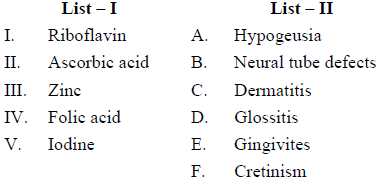
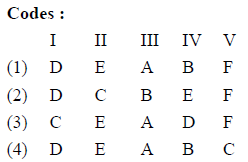
62. Match the organisms given in List – I with the disease caused in List – II.

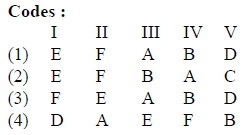
63. Match the category/age in List – I with their RDA for energy in List – II.
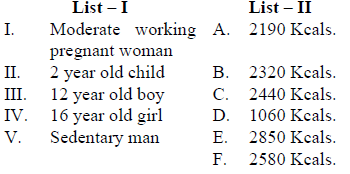
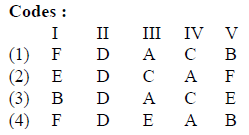
64. Match the nutrient in List – I with the method of estimation in List – II.

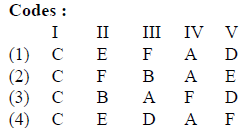
65. Match the items in List – I with their description in List – II.
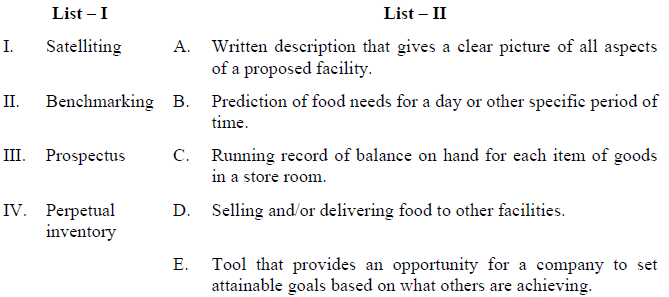

66. Match the finishes given in List – I with their purpose given in List – II.
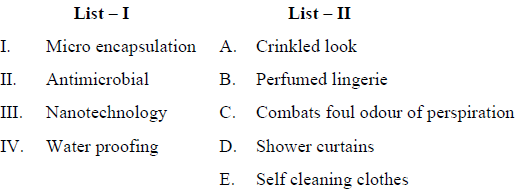
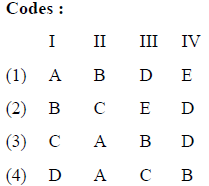
67. Match the types of wool given in List – I with their source given in List – II.
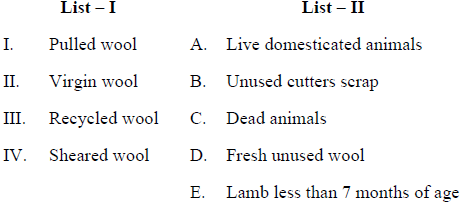
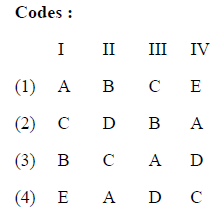
68. Match the knives given in List – I with their purpose given in List – II.

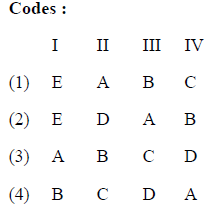
69. Match the items given in List-I with the items given in List-II :
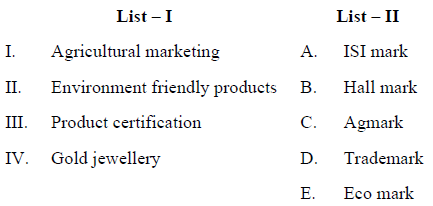
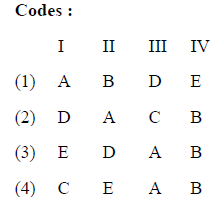
70. Match the items given in List-I with the items given in List-II :
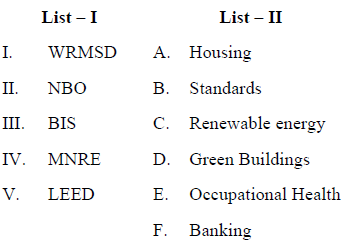

71. Match List – I with List – II.

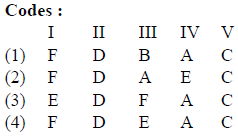
72. Match the List – I with List – II.
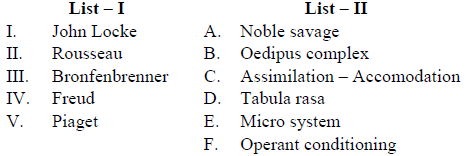
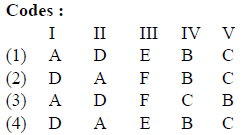
73. Match the items in List – I with List – II.

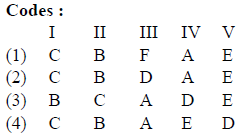
74. Match the concepts used in communication given under List – I with their related term or form given under List – II.

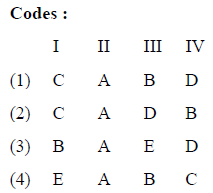
75. Match the types of Participatory Learning and Action technique (PLA) in List – I with their appropriate purposes given under List – II.


Latest Govt Job & Exam Updates: